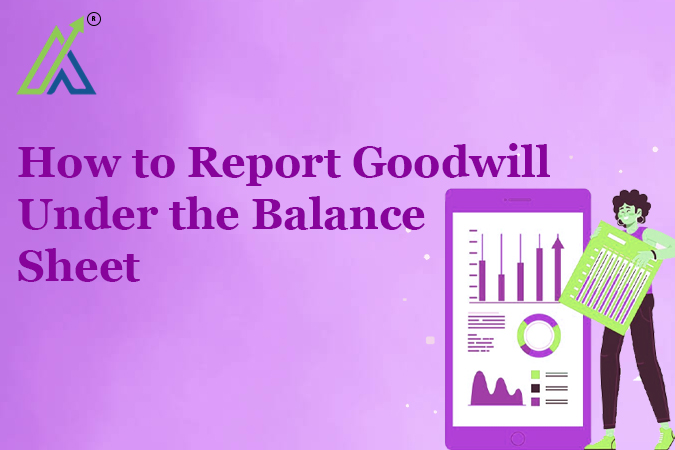Goodwill, often described as the premium paid for a company’s reputation, customer loyalty, and synergies, is a critical intangible asset in financial reporting. Its calculation and presentation on the balance sheet require precision, as it reflects strategic value beyond tangible resources. This blog explains how to calculate and report goodwill under the non-current assets section as an intangible asset, using the formula Goodwill = Consideration Transferred (C) + Non-Controlling Interest (NCI) – (Fair Value of Assets (A) – Fair Value of Liabilities (L)).
Understanding Goodwill in the Balance Sheet
Goodwill arises during business combinations when the total consideration paid (including non-controlling interests) exceeds the fair value of the acquired company’s net identifiable assets. It is classified under non-current intangible assets because it represents long-term strategic value. Unlike physical assets, goodwill is not amortized but is tested annually for impairment under accounting standards like Ind AS 36 or IFRS 3.
The Formula: Goodwill = C + NCI – (A – L)
The formula Goodwill = Consideration Transferred (C) + Non-Controlling Interest (NCI) – (Fair Value of Assets (A) – Fair Value of Liabilities (L)) is the cornerstone of goodwill calculation under the acquisition method. Let’s break down each component:
Consideration Transferred (C)
This is the total value paid to acquire the business, including:
- Cash, equity, or other assets transferred.
- Contingent payments (e.g., earn-outs linked to future performance).
- Direct acquisition costs (legal fees, advisory charges).
Non-Controlling Interest (NCI)
NCI represents the portion of the subsidiary not owned by the parent company, measured either at fair value or proportionate share of net identifiable assets.
Fair Value of Assets (A)
All identifiable assets (tangible and intangible) are revalued at their fair market value. Examples include:
- Tangible assets: Property, machinery, inventory.
- Intangible assets: Patents, trademarks, customer contracts.
Fair Value of Liabilities (L)
Liabilities assumed during acquisition, such as loans, payables, and contingent obligations, are measured at fair value.
Calculating Goodwill
Subtract the net identifiable assets (A – L) from the sum of consideration transferred and NCI:
Goodwill=C+NCI−(A−L)
If the result is positive, it represents the premium paid for intangible synergies. If negative (rare), it is recognized as a bargain purchase gain in the income statement.
Reporting Goodwill Under Non-Current Intangible Assets
Once calculated, goodwill is reported on the balance sheet as follows:
- Classification: Listed under Intangible Assets in the Non-Current Assets section.
- Presentation: Disclosed separately from other intangibles (e.g., software, licenses) due to its unique nature.
- Impairment Testing: Annually assessed for impairment; any loss reduces the carrying amount directly.
Example Balance Sheet Extract:
Non-Current Assets | Amount (In Rs.) |
Property, Plant & Equipment | 500,000 |
Intangible Assets | 250,000 |
– Goodwill | 200,000 |
– Patents | 50,000 |
Step-by-Step Calculation Example
Scenario: Company X acquires 80% of Company Y for ₹1,200,000. The fair value of the non-controlling interest (NCI) is ₹300,000.
- Fair Value of Assets (A): ₹1,000,000 (including ₹150,000 in trademarks).
- Fair Value of Liabilities (L): ₹400,000.
Calculation = 1,200,000 (C) + 300,000 (NCI) – (1,000,000 – 400,000)
= 1,500,000−600,000
= ₹900,000
Reporting:
- ₹900,000 is added to the Intangible Assets section under Non-Current Assets.
- Trademarks (₹150,000) are listed separately.
Challenges in Goodwill Calculation
Recognizing and measuring goodwill is complex due to various financial, legal, and market-driven factors. Key challenges include:
- Valuing Non-Controlling Interests (NCI):
- Measuring NCI at fair value versus proportionate share of net assets can lead to discrepancies.
- Contingent Liabilities:
- Estimating obligations like pending lawsuits requires expert judgment.
- Dynamic Market Conditions:
- Fluctuations in asset values (e.g., real estate) between deal signing and closure.
- Regulatory Compliance:
- Standards like Ind AS 103 mandate strict documentation of assumptions.
Disclosure Requirements
Transparency is critical. Companies must disclose:
- Basis for Fair Value Measurements: Methods used (market, income, or cost approach).
- NCI Valuation: Whether measured at fair value or proportionate share.
- Impairment Details: Loss amounts, triggers (e.g., economic downturns).
Example: A pharmaceutical company disclosed a ₹150 crore impairment loss due to failed drug trials, citing revised cash flow projections.
Impairment Testing: Protecting Balance Sheet Integrity
Annual tests ensure goodwill’s carrying amount does not exceed its recoverable amount (higher of value in use or fair value less disposal costs). For instance:
- A retail chain’s goodwill may be impaired if consumer demand shifts online.
- Impairment losses directly reduce the goodwill value on the balance sheet.
Common Pitfalls to Avoid
Errors in goodwill calculation can lead to financial misstatements and regulatory scrutiny. Key pitfalls include:
- Overlooking NCI: Excluding NCI undervalues goodwill and misrepresents acquisition scope.
- Inconsistent Valuation Methods: Changing approaches between periods distorts comparability.
- Ignoring Liabilities: Underestimating obligations skews net asset values.
Questions to Understand your Ability
Q1.) Under the acquisition method, goodwill is calculated using which formula?
a) Goodwill = Consideration Transferred – Fair Value of Net Assets
b) Goodwill = Consideration Transferred + Non-Controlling Interest – (Fair Value of Assets – Fair Value of Liabilities)
c) Goodwill = Fair Value of Liabilities – Fair Value of Assets + Consideration Transferred
d) Goodwill = Consideration Transferred + Fair Value of Liabilities – Fair Value of Assets
Q2.) Where is goodwill reported in the balance sheet?
a) Under Current Assets
b) Under Shareholders’ Equity
c) Under Non-Current Intangible Assets
d) Under Contingent Liabilities
Q3.) If goodwill calculation results in a negative value, how is it treated?
a) It is classified as a deferred tax liability
b) It is written off against retained earnings
c) It is recognized as a bargain purchase gain in the income statement
d) It is amortized over time
Q4.) What is the primary reason goodwill is not amortized under Ind AS 36 or IFRS 3?
a) Goodwill is considered to have an indefinite useful life
b) Goodwill is a tangible asset
c) Goodwill is a liability that needs to be settled
d) Goodwill is directly expensed at acquisition
Q5.) Which of the following is NOT a challenge in goodwill calculation?
a) Measuring Non-Controlling Interests (NCI)
b) Determining contingent liabilities
c) Fluctuations in market conditions
d) Amortization of goodwill over time
Conclusion
Reporting goodwill under the balance sheet is a blend of art and science. By rigorously applying the C + NCI – (A – L) formula, classifying it correctly under non-current intangible assets, and adhering to disclosure standards, companies can maintain transparency and investor trust. In an era where intangible value drives business success, mastering goodwill reporting is not just compliance—it’s a strategic imperative.
FAQ's
Goodwill represents the excess of the total consideration paid (including NCI) over the fair value of net identifiable assets acquired in a business combination.
Goodwill = Consideration Transferred (C) + Non-Controlling Interest (NCI) – (Fair Value of Assets (A) – Fair Value of Liabilities (L)).
Goodwill is listed under Non-Current Intangible Assets, separate from other intangibles like patents or trademarks.
No, goodwill is not amortized but is tested annually for impairment under Ind AS 36 or IFRS 3.
A negative goodwill amount is treated as a bargain purchase gain and recognized in the income statement.
Goodwill impairment is assessed annually by comparing it carrying amount to the recoverable amount (higher of value in use or fair value less costs to sell).
Challenges include valuing NCI, contingent liabilities, market fluctuations, and ensuring regulatory compliance (Ind AS 103).
Common errors include excluding NCI, inconsistent valuation methods, and underestimating liabilities, leading to financial misstatements.


